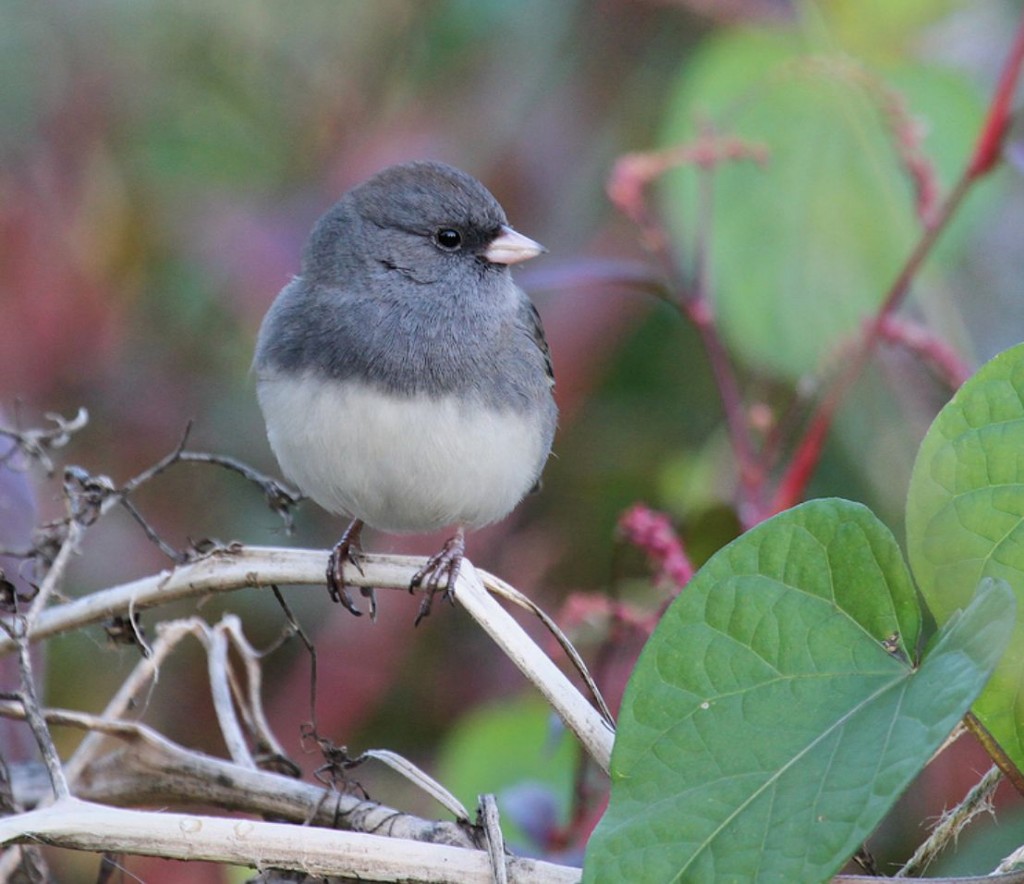
Dark-eyed (Slate-colored) Junco, Ryan Schain
Continental Summary
Light to moderate flights in the West, particularly the northern extents, featured American Wigeon, Ring-necked Duck, Northern Flicker, Varied Thrush, Golden-crowned Sparrow, and Dark-eyed Junco, while the East saw moderate to very heavy flights from the middle of the period that featured Tundra Swan, Northern Pintail, Golden-crowned Kinglet, Ruby-crowned Kinglet, Lincoln’s Sparrow, White-crowned Sparrow, Fox Sparrow, and Dark-eyed Junco.
Want to know what species will be on the move now? Check out our forecast!
Need a review of our definitions for regions, species on the move, and migration amounts? Please visit this link.
Quick Links to Regions
Upper Midwest and Northeast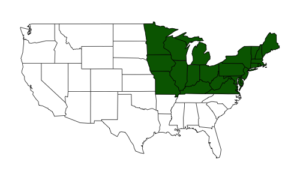 |
Gulf Coast and Southeast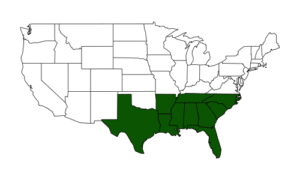 |
Great Plains |
West |
Upper Midwest and Northeast
Scattered light to locally heavy movements occurred across the region from the weekend through the early portion of the work week, as patches of favorable and marginal conditions allowed some birds to take flight. Changes arrived by Monday night in the Upper Midwest, where heavy and very heavy flights occurred; Tuesday saw these flights extend to the east behind the frontal passage. Wednesday and Thursday nights’ flights were extensive, though tempered to primarily moderate to locally heavy intensities. Note the exception in New England, where the effects (primarily extensive precipitation) of a strong low pressure center kept birds grounded.
Top Movers
Increasing
| Species | Increase from Last Week | % of Checklists Reporting |
|---|---|---|
| White-crowned Sparrow | 174% | 4.4 |
| Dark-eyed Junco | 92% | 6.8 |
| Golden-crowned Kinglet | 114% | 5 |
| Fox Sparrow | 715% | 0.8 |
| Ruby-crowned Kinglet | 36% | 10.4 |
| Harris's Sparrow | 345% | 0.6 |
| White-throated Sparrow | 24% | 15 |
| Dunlin | 46% | 2.1 |
| Hermit Thrush | 51% | 3 |
| Pine Siskin | 124% | 0.9 |
| Brown Creeper | 38% | 3.2 |
| Yellow-rumped Warbler | 19% | 20 |
| Orange-crowned Warbler | 48% | 2.1 |
| Rusty Blackbird | 60% | 1.1 |
| American Pipit | 40% | 2.1 |
| Swamp Sparrow | 21% | 9 |
| Ring-necked Duck | 79% | 0.8 |
| Winter Wren | 35% | 2 |
Decreasing
| Species | Decrease from Last Week | % of Checklists Reporting |
|---|---|---|
| Red-eyed Vireo | -59% | 5 |
| Ruby-throated Hummingbird | -48% | 5.7 |
| Broad-winged Hawk | -65% | 1.3 |
| Chestnut-sided Warbler | -60% | 1.5 |
| American Redstart | -40% | 8.7 |
| Scarlet Tanager | -54% | 2.1 |
| Philadelphia Vireo | -61% | 1.1 |
| Yellow-throated Vireo | -68% | 0.6 |
| Common Yellowthroat | -34% | 15.3 |
| Black-and-white Warbler | -43% | 5.8 |
| Wilson's Warbler | -61% | 0.9 |
| Eastern Wood-Pewee | -40% | 6.2 |
| Magnolia Warbler | -37% | 8 |
| Blue-gray Gnatcatcher | -77% | 0.4 |
| Cedar Waxwing | -29% | 14.7 |
| Rose-breasted Grosbeak | -38% | 5.2 |
| Cape May Warbler | -52% | 1.7 |
| Swainson's Thrush | -41% | 5.7 |
| White-eyed Vireo | -50% | 1.2 |
| Black-throated Green Warbler | -39% | 7.5 |
| Gray Catbird | -24% | 33.9 |
| House Wren | -31% | 8.4 |
| Bay-breasted Warbler | -47% | 2 |
| Least Flycatcher | -63% | 0.5 |
| Northern Parula | -36% | 5 |
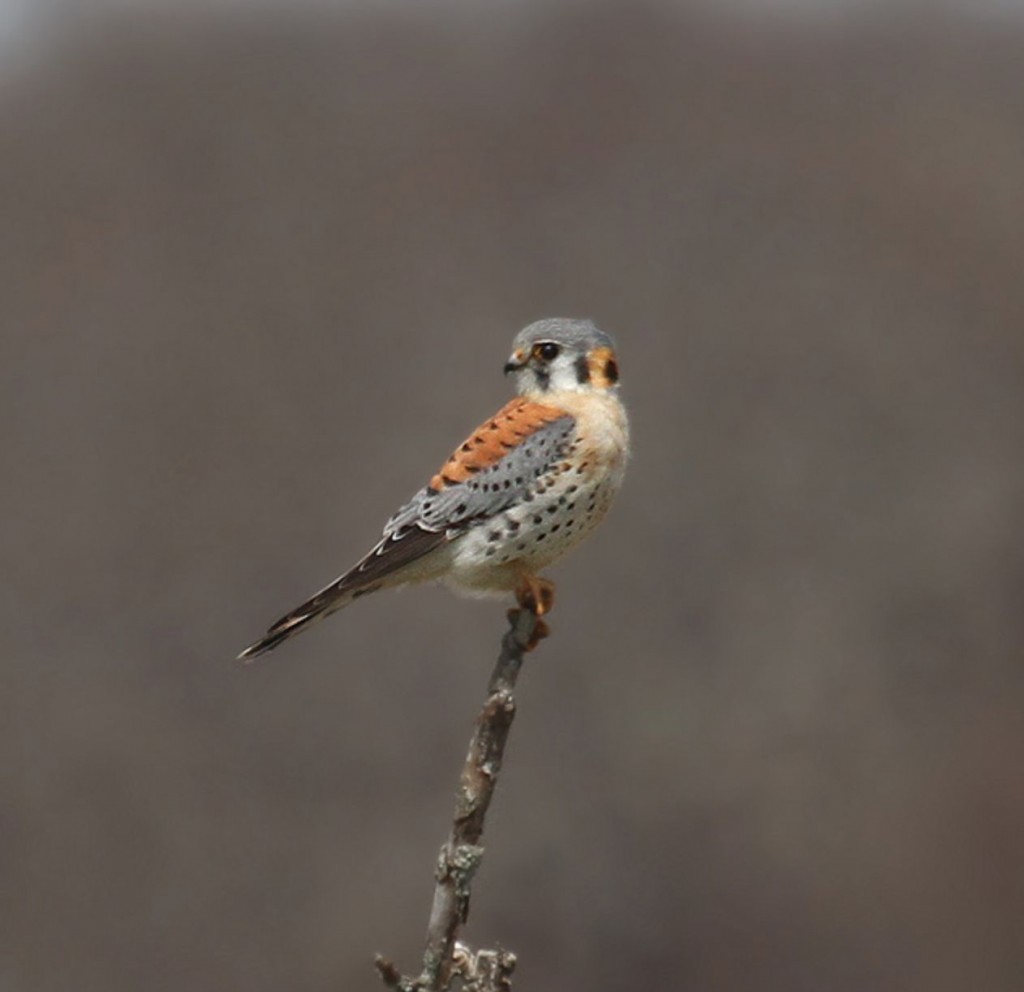
American Kestrel, Ryan Schain
Gulf Coast and Southeast
Moderate to heavy flights graced the western reaches of the region, primarily in Texas, for the first half of the period. Movements farther east were generally more localized and of lesser intensities. But Tuesday night saw region wide flights, varying from moderate movements in the southeastern coastal Plain to heavy flight in the Mississippi River valley and over Texas. The intensities of the flights increased on Wednesday night in the Florida Panhandle and in the southern Appalachians. Note that Thursday night saw continued heavy flights along parts of the Gulf Coast, while the Carolinas experienced a full halt to the system in extensive precipitation.
Top Movers
Increasing
| Species | Increase from Last Week | % of Checklists Reporting |
|---|---|---|
| Ruby-crowned Kinglet | 62% | 3.5 |
| Peregrine Falcon | 39% | 2.8 |
| American Kestrel | 26% | 7.8 |
| House Wren | 36% | 4.1 |
| Orange-crowned Warbler | 42% | 1.3 |
| Lincoln's Sparrow | 90% | 0.6 |
| Gray Catbird | 16% | 17 |
| Yellow-rumped Warbler | 52% | 0.8 |
| Brown Thrasher | 17% | 19.4 |
| Northern Flicker | 15% | 10.9 |
| Gray-cheeked Thrush | 31% | 1.5 |
| Nelson's Sparrow | -2650% | 0.2 |
| Northern Mockingbird | 13% | 52.8 |
| Sharp-shinned Hawk | 22% | 2.2 |
| Boat-tailed Grackle | 13% | 9.8 |
| Savannah Sparrow | 41% | 0.6 |
| Palm Warbler | 11% | 5.6 |
| Northern Harrier | 16% | 2.1 |
| Northern Pintail | 43% | 0.5 |
| Ruddy Duck | 38% | 0.5 |
Decreasing
| Species | Decrease from Last Week | % of Checklists Reporting |
|---|---|---|
| Baltimore Oriole | -54% | 2.3 |
| Great Crested Flycatcher | -52% | 1.9 |
| Cape May Warbler | -46% | 1.3 |
| Yellow Warbler | -35% | 5.5 |
| Yellow-throated Vireo | -36% | 2.6 |
| Least Flycatcher | -52% | 0.8 |
| Purple Martin | -67% | 0.4 |
| Hooded Warbler | -33% | 2.9 |
| Bank Swallow | -79% | 0.1 |
| Veery | -37% | 1.2 |
| Red-eyed Vireo | -24% | 9.3 |
| Bobolink | -54% | 0.4 |
| Summer Tanager | -26% | 7.3 |
| Canada Warbler | -60% | 0.3 |
| Blackburnian Warbler | -36% | 1.3 |
| Eastern Kingbird | -31% | 2 |
| Black Tern | -66% | 0.3 |
| Orchard Oriole | -60% | 0.3 |
| Acadian Flycatcher | -32% | 2 |
| Blue-winged Warbler | -39% | 0.8 |
| Black-and-white Warbler | -20% | 7.6 |

Tundra Swans, Ian Davies
Great Plains
A light to moderate pulse in the central and southern Plains kicked off the weekend, followed by heavier migration on Sunday night in the northern reaches of the region. After a frontal boundary pushed through the region on Monday night, with some moderate to heavy flights in tow, much larger and heavier movements occurred on Tuesday night; these were primarily in the central and southern Plains. Following this large pulse of birds, the remainder of the period was generally quiet, with much more localized and lower intensity movements.
Top Movers
Increasing
| Species | Increase from Last Week | % of Checklists Reporting |
|---|---|---|
| Dark-eyed Junco | 83% | 10.4 |
| Ruby-crowned Kinglet | 73% | 24.4 |
| White-throated Sparrow | 80% | 12.3 |
| Yellow-rumped Warbler | 49% | 27.7 |
| Golden-crowned Kinglet | -1379% | 0.9 |
| Tundra Swan | 348% | 0.9 |
| Orange-crowned Warbler | 28% | 20.2 |
| Nashville Warbler | 34% | 16.9 |
| Lesser Scaup | 55% | 1.7 |
| American Pipit | 52% | 1.7 |
| Sharp-shinned Hawk | 24% | 5.3 |
| Osprey | 17% | 11.9 |
| Harris's Sparrow | 44% | 2.1 |
Decreasing
| Species | Decrease from Last Week | % of Checklists Reporting |
|---|---|---|
| Yellow Warbler | -94% | 0.1 |
| Ruby-throated Hummingbird | -54% | 4.2 |
| Common Nighthawk | -60% | 2.7 |
| Cliff Swallow | -88% | 0.3 |
| Red-eyed Vireo | -47% | 2.8 |
| Blue-gray Gnatcatcher | -58% | 1 |
| Black Tern | -65% | 0.6 |
| Wilson's Phalarope | -93% | 0.1 |
| Least Flycatcher | -51% | 0.7 |
| Bank Swallow | -74% | 0.3 |
| Warbling Vireo | -37% | 2 |
| Say's Phoebe | -67% | 0.3 |
| Black-and-white Warbler | -44% | 1.3 |
| Barn Swallow | -25% | 13 |
| Cooper's Hawk | -24% | 6.6 |
| Philadelphia Vireo | -41% | 1.1 |
| Yellow-headed Blackbird | -44% | 1 |
| Semipalmated Plover | -54% | 0.5 |
| Yellow-throated Vireo | -59% | 0.2 |
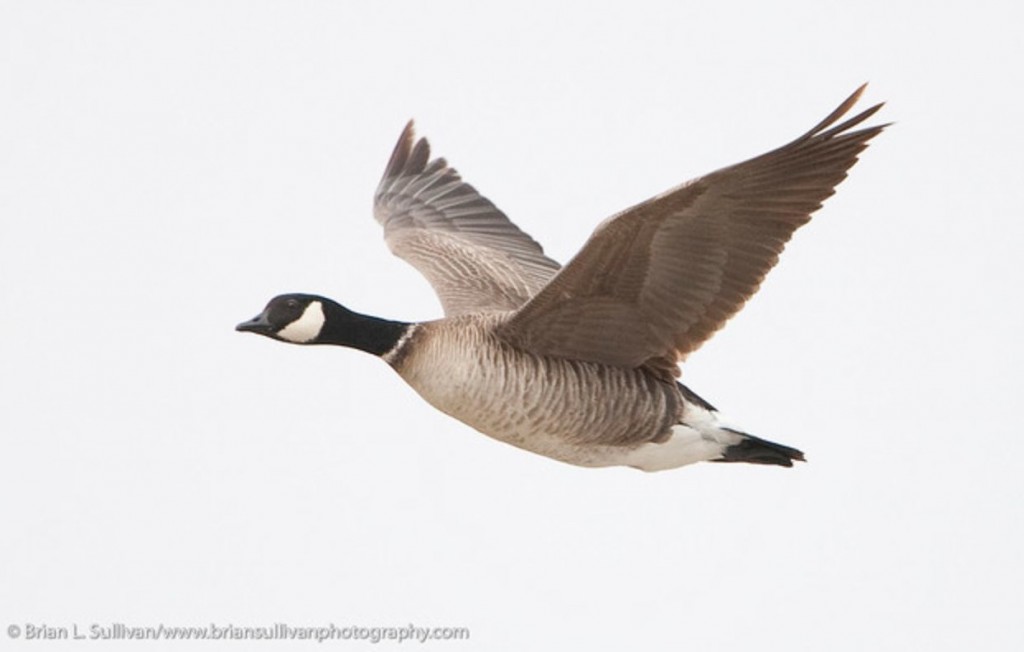
Cackling Goose, Brian Sullivan
West
Light to moderate flights kicked off the weekend, with the most intense of these occurring in the Pacific Northwest and northern Rockies on Saturday night. Beginning on Monday night, light to moderate flights continued in many areas across the region, gradually diminishing over the course of the week as conditions became less favorable (and scattered precipitation increased). By the end of the week, movements were substantially more localized to portions of the Pacific Northwest, central California, and portions of the southern Rockies.
Top Movers
Increasing
| Species | Increase from Last Week | % of Checklists Reporting |
|---|---|---|
| Golden-crowned Sparrow | 33% | 14.4 |
| Yellow-rumped Warbler | 25% | 31.1 |
| Ruby-crowned Kinglet | 29% | 13.3 |
| Dark-eyed Junco | 22% | 23.1 |
| Fox Sparrow | 29% | 7.5 |
| Ring-necked Duck | 28% | 3.7 |
| White-throated Sparrow | 119% | 1 |
| Varied Thrush | 36% | 2.4 |
| American Wigeon | 14% | 7.8 |
| White-crowned Sparrow | 7% | 33.5 |
| Eurasian Wigeon | 315% | 0.3 |
| Cackling Goose | 19% | 2.3 |
| Western Meadowlark | 11% | 8.3 |
| Northern Flicker | 9% | 33.2 |
| Spotted Towhee | 9% | 21.1 |
Decreasing
| Species | Decrease from Last Week | % of Checklists Reporting |
|---|---|---|
| Western Tanager | -42% | 3.7 |
| Caspian Tern | -53% | 1.1 |
| MacGillivray's Warbler | -49% | 0.9 |
| Wilson's Warbler | -35% | 6.4 |
| Willow Flycatcher | -50% | 0.8 |
| Vaux's Swift | -36% | 1.1 |
| Gray Catbird | -67% | 0.2 |
| Barn Swallow | -32% | 8.6 |
| Warbling Vireo | -33% | 3.1 |
| Brewer's Sparrow | -41% | 1.2 |
| Hooded Oriole | -73% | 0.2 |
| Nashville Warbler | -44% | 0.7 |
| Black-headed Grosbeak | -54% | 0.6 |
| Violet-green Swallow | -27% | 1.9 |
| Lazuli Bunting | -46% | 0.7 |
| Blue Grosbeak | -48% | 0.6 |
| Hammond's Flycatcher | -52% | 0.3 |
| Dickcissel | -65% | 0.1 |
| Pacific-slope Flycatcher | -30% | 2.3 |
| Green-tailed Towhee | -31% | 1.5 |
| Swainson's Thrush | -31% | 1.7 |
| Yellow Warbler | -24% | 9.3 |
–––––––––––––––––––––––––––––––––––
Farnsworth and Van Doren




